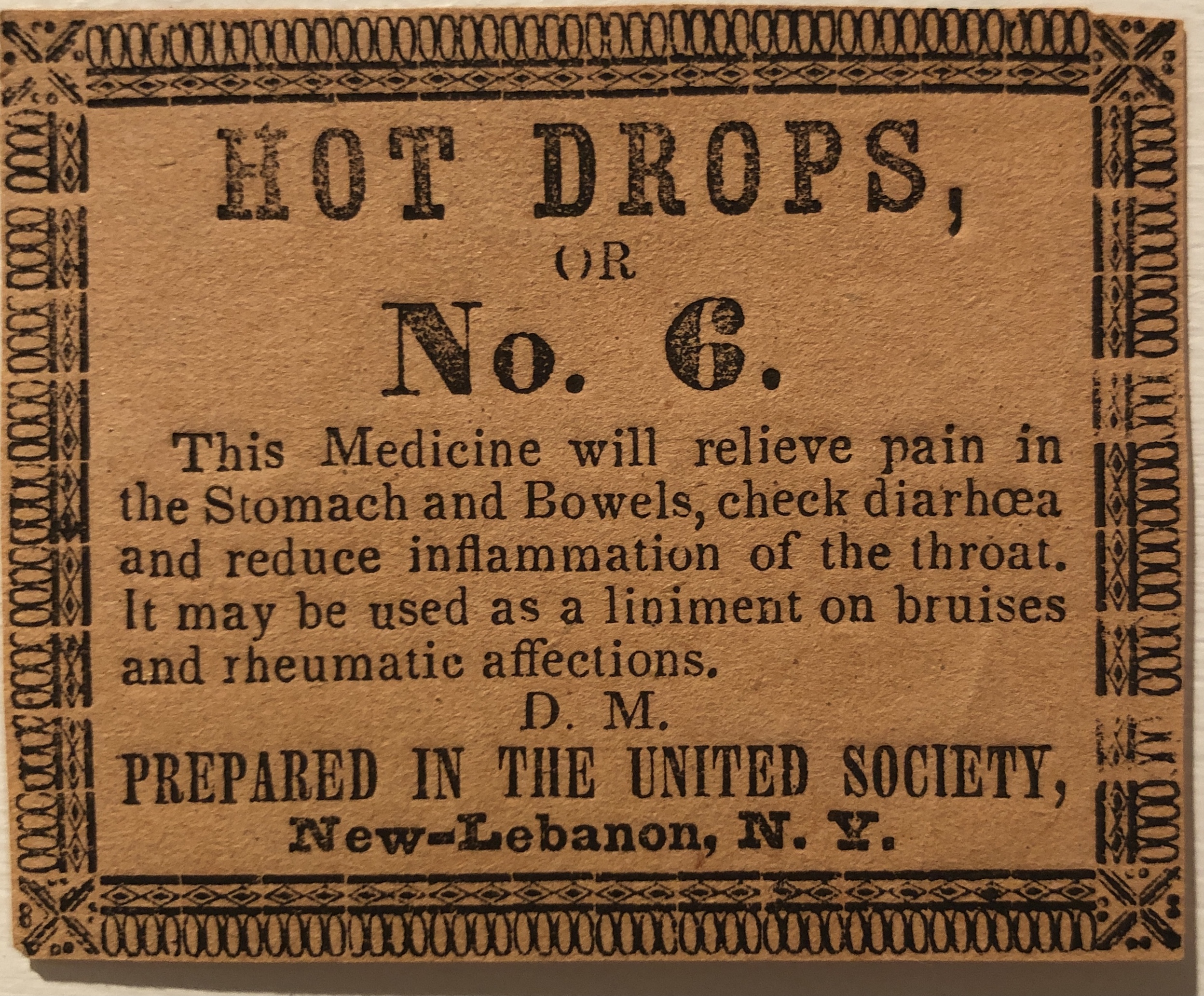
“Hot Drops or No. 6 . . . Prepared in the United Society, New-Lebanon, N. Y.,” n.d., Mount Lebanon, NY.
Shaker medical practice was eclectic. While they availed themselves of non-Shaker doctors when needed, they tried a number of other medical treatment modalities over the years. They treated a variety of illnesses with “electric” medicine – the generation and application of static electric shocks to relieve pain and effect cures. In fact, they were well enough […]
Shaker medical practice was eclectic. While they availed themselves of non-Shaker doctors when needed, they tried a number of other medical treatment modalities over the years. They treated a variety of illnesses with “electric” medicine – the generation and application of static electric shocks to relieve pain and effect cures. In fact, they were well enough versed in this practice that sometime after Brother Thomas Brown decided to abandon Shaker life, he was able to write a book – The Ethereal Physician: Or Medical Electricity Revived; Its Pretensions Fairly and Candidly Considered and Examined, and Its Efficacy Proved, in the Prevention and Cure of a Great Variety of Diseases (1817) (See our earlier blog post on the topic.) During the mid-nineteenth century, they became practitioners of a variety of treatments that fell under the category of “water-cure.” Joel Shew, one of the most prolific authors on the subject and best known practitioners, was the doctor in residence at the resort-like water-cure establishment that developed in Lebanon Springs – giving the Mount Lebanon Shakers convenient access to his expertise. They even explored the medical and psychological advantages that might be derived from the practice of phrenology. Shakers traveled to the ocean to “take the salt air” for their health; they built and lived in well-ventilated buildings, separated sick members of their communities from the healthy ones in purpose-built infirmaries and sick rooms, occasionally chose to eat a vegetarian diet; and learned about how calisthenics could improve their health. 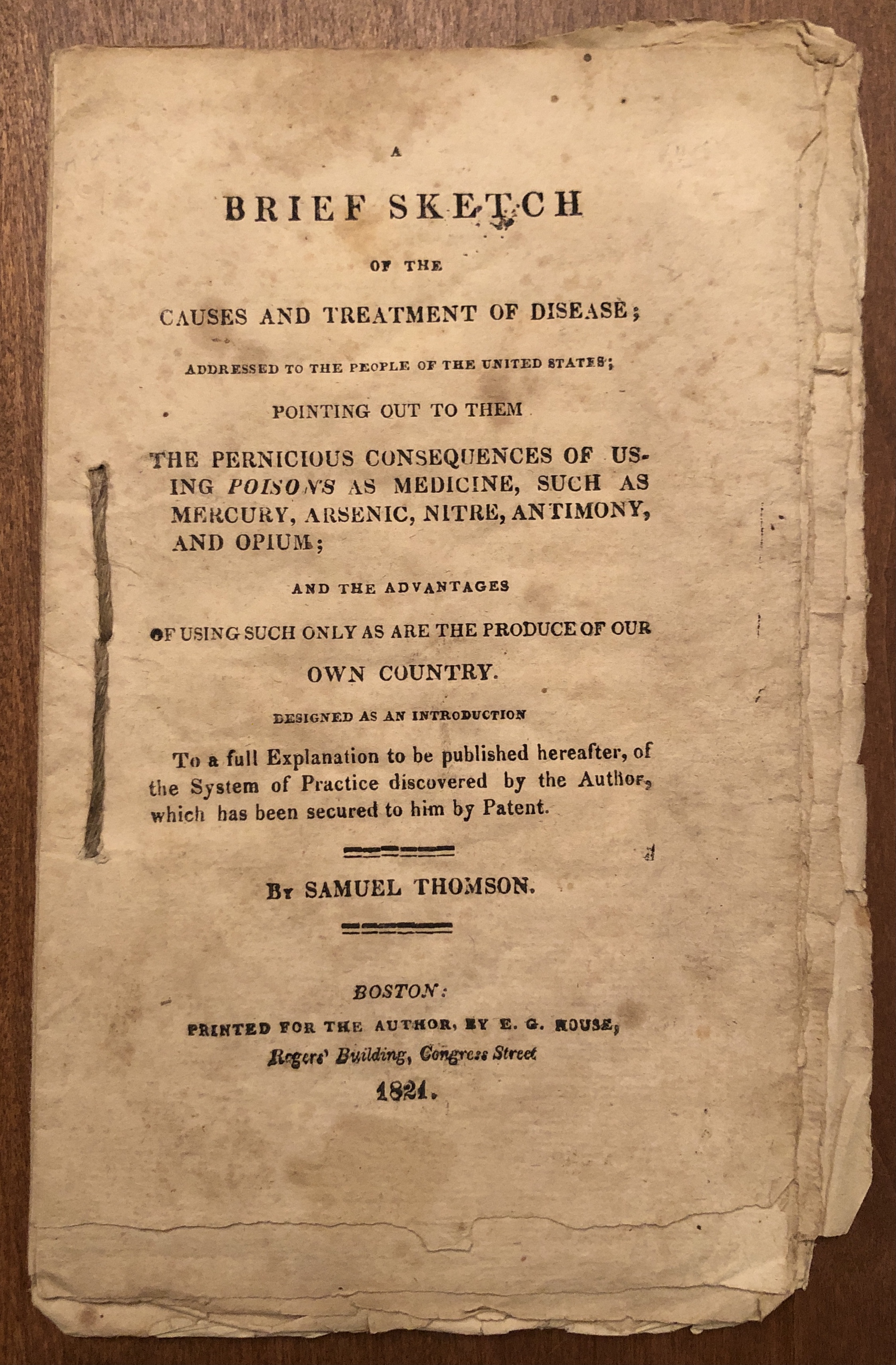
Though all of this, the Shakers primarily relied on what is now called naturopathic medicine – a practice using preparations derived from herbs and other natural plant materials. By the 1820s Shakers in several communities had taken up a system of herbal treatment developed and promoted by the self-trained doctor and rapidly developing entrepreneur, Samuel Thomson. Thomson was born in Alstead, New Hampshire, in 1769. His family was a farming family and relatively isolated. Their medical care, as he recalls in his A Narrative, of the Life and Medical Discoveries of Samuel Thomson (1822), was undertaken by the widow Benton who had learned the use of herbs in healing from Native Americans. In his late teens, Thomson’s mother died of consumption at the hands of regular doctors using mercury, opium, vitriol (sulphates), and other medicines that, in Samuel’s opinion, tended only to weaken her. Then following the near death of his wife after the birth of their first child – again at the hands of regular doctors – Thomson engaged “root doctors” who were able to restore her to health. During the ensuing years Thomson took the opportunity to learn what he could of herbal practice and by 1805 was in the position of choosing between a life of farming or one of practicing medicine. He chose the latter and, quoting John S. Haller, Jr., Thomson’s most recent biographer, “resolved to making his fortune and combined a strong work ethic with perseverance, opportunity, and entrepreneurship. This itinerant people’s doctor promised to release patients from the tyranny of regular physicians … by offering cheap and kindly medicines from their own field and gardens.” John S. Haller, Jr. The People’s Doctor: Samuel Thomson and the American Botanical Movement, 1790-1860 [Carbondale, Southern Illinois University Press, 2000]. Thomson prepared a pamphlet decrying the regular practice of medicine in 1821 and in book form, his autobiography and a description of his theory and method of treatment in 1822. Thomson’s Narrative … and his New Guide to Health, or Botanic Family Physician: Containing a Complete System of Practice upon a Plan Entirely New (1822) went through many editions – of relatively large press runs – both of Thomson’s initiation and by those who, to Thomson’s perpetual irritation, printed unauthorized copies.
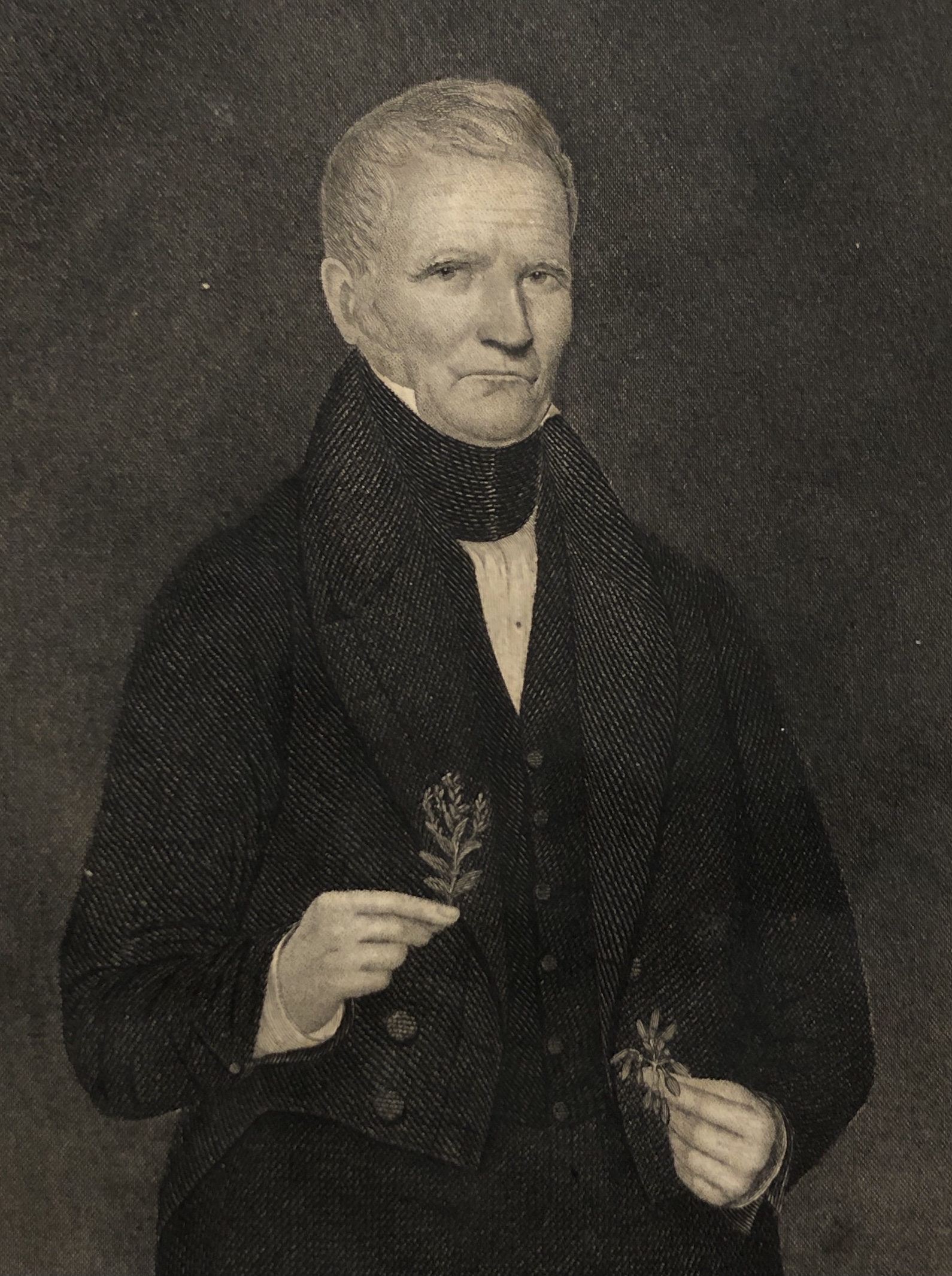
The portrait of Thomson from his son Cyrus’s Dr. Thomson’s Materia Medica: A Book for Everybody; … Designed to be a Substitute for the Family Physician (1863) shows the doctor holding two plants – in his right hand lobelia inflata and in his left a type of capsicum annuum (cayenne pepper) – that were the two basic building blocks of the Thomsonian System. In oversimplified terms, Thomson observed that in life there is heat and in death, cold. Especially in cases where exposure to cold may have caused illness, he treated patients with lobelia, an emetic, to empty the stomach, and followed it with ample doses of cayenne pepper (and occasionally with blanket wraps and steam) to restore the body’s natural heat. Thomson’s approach, seemingly less harmless than the bleeding and ingestion of mercury and sugar of lead given by regular physicians, also appealed to an increasingly anti-elitist Jacksonian America where those who lived in areas not serviced by other doctors, could heed the old adage of “Every man his own physician.”
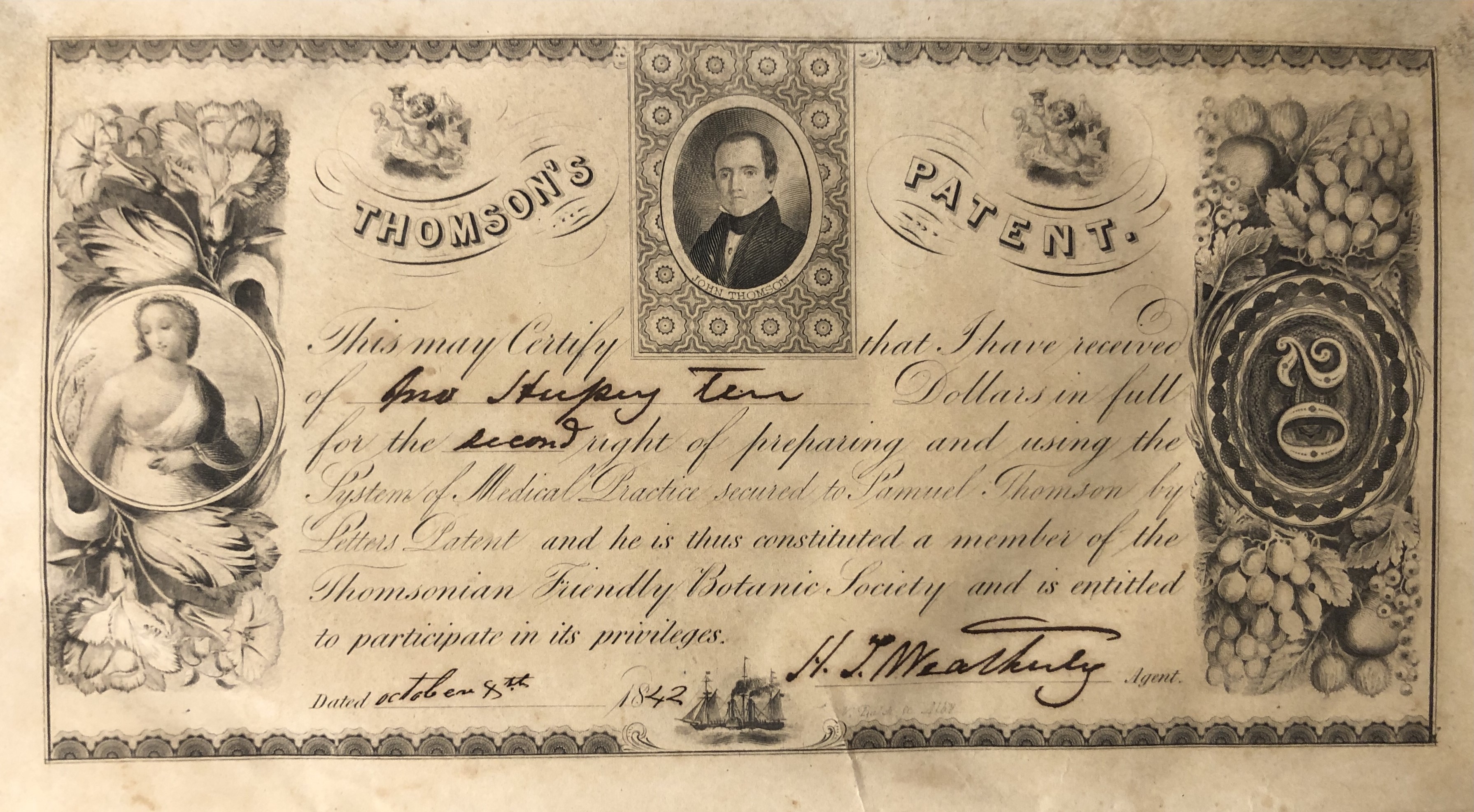 By the late 1820s references to the treatment of sick Shakers using the Thomsonian system began to appear in their journals, and Shaker recipe books included Thomsonian formulas. In October, 1834, at Mount Lebanon’s North Family two sisters, “Anna Gates and Caroline Wood commence a course of Thomsonian doctoring this week; a tedious process but such is the nature of the troubles we have to contend with, while encumbered with this perishable body.” In 1849, Sister Anna Whites’ father, Robert, fell ill at his home in Canaan, New York. Brother Henry Stone was sent to see him and administer a course of Thomsonian medicine. As late as 1873, when Brother Oliver Prentiss of the North Family, Mount Lebanon, was “hurt by a rusty spike, and was near dying. [He was] Cured with hot water & doses of No. 6.” “No. 6,” officially known as Thomson’s Compound Tincture of Myrrh and Capsicum or Rheumatic Drops – prepared with wine or brandy – was prescribed to remove pain and prevent mortification. It acted as a powerful antiseptic.
By the late 1820s references to the treatment of sick Shakers using the Thomsonian system began to appear in their journals, and Shaker recipe books included Thomsonian formulas. In October, 1834, at Mount Lebanon’s North Family two sisters, “Anna Gates and Caroline Wood commence a course of Thomsonian doctoring this week; a tedious process but such is the nature of the troubles we have to contend with, while encumbered with this perishable body.” In 1849, Sister Anna Whites’ father, Robert, fell ill at his home in Canaan, New York. Brother Henry Stone was sent to see him and administer a course of Thomsonian medicine. As late as 1873, when Brother Oliver Prentiss of the North Family, Mount Lebanon, was “hurt by a rusty spike, and was near dying. [He was] Cured with hot water & doses of No. 6.” “No. 6,” officially known as Thomson’s Compound Tincture of Myrrh and Capsicum or Rheumatic Drops – prepared with wine or brandy – was prescribed to remove pain and prevent mortification. It acted as a powerful antiseptic.
 The Shakers, being in the herbal medicine business themselves, could have easily formulated any of Thomson’s six basic medicines. The two labels included here – “Thompsonian Spice Bitters” and “Hot Drops or No. 6” were made and sold by the Shakers at Mount Lebanon. It could be Thomson’s displeasure with the Shakers – he was unhappy with the Shakers’ agents, the Brothers Hibbard, in New York City, for the stiff competition they gave his own dispensary in the city – or, evidenced by his 1831 suit against the Harvard Shakers’ Trustee, Brother Hosea Winchester, for ten thousand dollars for his sale of inferior products marketed as genuine Thomsonian medicines – that led the Shakers to misspell Thomson’s name on the Spice Bitters and not include it at all on the Hot Drops. Thomson lost the law suit as Brother Hosea had legally purchased Thomson’s Patent in 1817.
The Shakers, being in the herbal medicine business themselves, could have easily formulated any of Thomson’s six basic medicines. The two labels included here – “Thompsonian Spice Bitters” and “Hot Drops or No. 6” were made and sold by the Shakers at Mount Lebanon. It could be Thomson’s displeasure with the Shakers – he was unhappy with the Shakers’ agents, the Brothers Hibbard, in New York City, for the stiff competition they gave his own dispensary in the city – or, evidenced by his 1831 suit against the Harvard Shakers’ Trustee, Brother Hosea Winchester, for ten thousand dollars for his sale of inferior products marketed as genuine Thomsonian medicines – that led the Shakers to misspell Thomson’s name on the Spice Bitters and not include it at all on the Hot Drops. Thomson lost the law suit as Brother Hosea had legally purchased Thomson’s Patent in 1817. 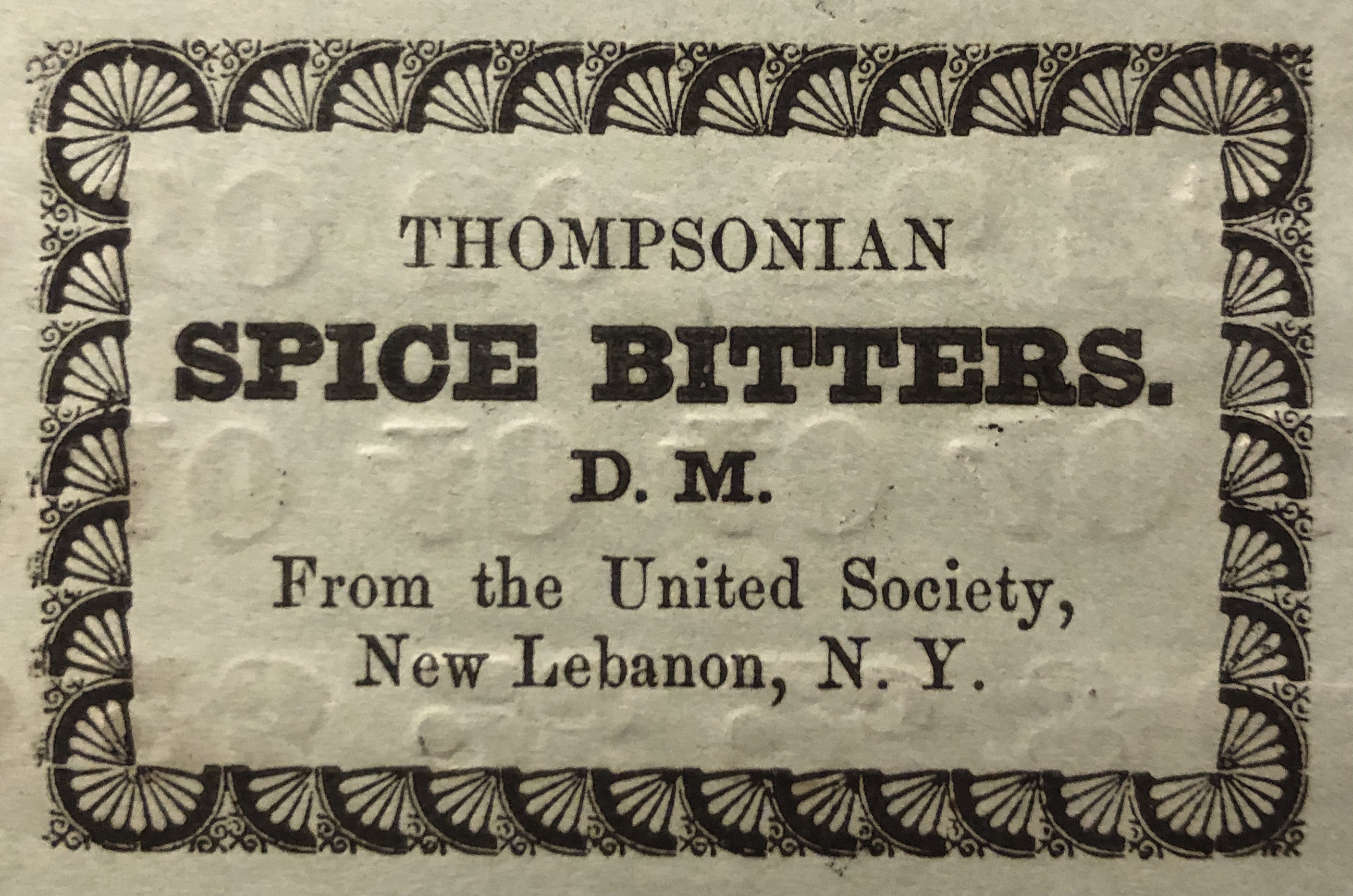
Shaker Museum recently received the gift of a collection of books and serials that enhances its ability to look at the Shakers’ use of herbal medicines in the wider context of this method of treatment in the world outside their communities. The collection of materials on herbal medicine contains books by Thomson in a number of editions, books by his supporters and practitioners, and books by those who found him in the “quackery” category of medical practitioners. The list – arranged alphabetically – follows below.
Materials Related to the Practice of Botanic Medicine with a Special Emphasis on the Thomsonian System and the Publications of Samuel Thomson
Books
Brown, John A. Quackery Exposed!!! Or a Few Remarks on the Thomsonian System of Medicine; Containing Testimonies and Extracts from Various Writers … [Boston, 1842].
Buchan, William. Domestic Medicine, or, A Treatise on the Prevention and Cure of Diseases, by Regimen and Simple Medicines: with Observations on Sea-Bathing and the Use of the Mineral Waters. [Exeter, Great Britain: J. & B. Williams, 1843].
Brigham, H. H. Facts and Statements, Compiled from the Most Eminent Medical Authors, Showing the Effects of the Mineral and Old School Practice on our Health and Constitution, also a Glance at the Merits of the Vegetable Practice of Medicine. [Fitchburg: Printed by George A. White, 1846].
Clymer, R. Swinburne. The Medicines of Nature. The Thomsonian System. [Quakertown, PA: Published by The Humanitarian Society, 1926].
Clymer, R. Swinburne. The Medicines of Nature. The Thomsonian System. [Quakertown, PA: Published by The Humanitarian Society, 1960].
Coffin, A. I. Medical Botany; A Course of Lectures Delivered at Sussex Hall, during 1850. [London: Published by W. B. Ford, [1851].
Colby, Benjamin. A Guide to Health, Being an Exposition of the Principles of the Thomsonian System of Practice and Their Mode of Application in the Cure of Every Form of Disease,… [Milford, NH: John Burns, 1846].
Comfort, W. J. The Practice of Medicine on Thomsonian Principles, Adapted as well to the Use of Families as to that of the Practitioner. Containing a Biographical Sketch of Dr. Thomson, … with Practical Directions for Administering the Thomsonian Medicines, … [Philadelphia: Lindsay & Blakiston, 1854, Fifth Edition].
Day, L. Meeker. The Improved American Family Physician: or, Sick Man’s Guide to Health: Containing a Complete Theory of the Botanic Practice of Medicine, on the Thomsonian and Hygeian System, with Alterations and Improvements. To which is appended, a concise formula for compounding medicines … Also, a complete digest on midwifery. [New York: n. p., 1833].
Emmons, Samuel B. The Vegetable Family Physician; Containing a Description of the Roots and Herbs Common to this Country … [Boston: George P. Oakes, 1836].
Fox, William. The Working Man’s Model Family Botanic Guide or, Every Man His Own Doctor; Being an Exposition of The Botanic System, … [Sheffield: William Fox and Sons, Medical Botanists. 1889, Twelfth Edition].
Fox, William The Working Man’s Model Family Botanic Guide or, Every Man His Own Doctor; Being an Exposition of The Botanic System, … [Sheffield: William Fox and Sons, Medical Botanists. 1904, Seventeenth Edition].
Robertson, F. K. The Book of Health, or Thomsonian Theory and Practice of Medicine, Including the Latest Views of Physiology, Pathology, and Therapeutics … also, Description of Disease, Medical Practice, and Materia Medica, by Silas Wilcox. [Bennington: Printed by J. I. C. & A. S. C. Cook, 1843]. Copy 1.
Robertson, F. K. The Book of Health, or Thomsonian Theory and Practice of Medicine, Including the Latest Views of Physiology, Pathology, and Therapeutics … also, Description of Disease, Medical Practice, and Materia Medica, by Silas Wilcox. [Bennington: Printed by J. I. C. & A. S. C. Cook, 1843]. Copy 2.
Robinson, Samuel. A Course of Fifteen Lectures on Medical Botany, Denominated Thomson’s New Theory of Medical Practice; in which the Various Theories that Have Preceded it Are Reviewed and Compared. [Boston: J. Howe, Printer, 1834].
Sanborn, P. E. The Sick Man’s Friend, Being a Plain, Practical Medical Work, on Vegetable or Botanical Principles Designed for the Use of Families and Individuals. [Boston: Published by William Johnson, 1844].
State of New-York. No. 354. In Assembly, May 12, 1840. “Report Of the minority of the select committee, to which was referred numerous petitions asking a change of the law towards Thomsonian physicians.”
Thomson, Cyrus. Dr. Thomson’s Materia Medica: A Book for Everybody; … Designed to be a Substitute for the Family Physician. [Geddes, NY: Published by Cyrus Thomson, 1863].
Thomson, Samuel. A Brief Sketch of the Causes and Treatment of Disease; Addressed to the People of the United States; Pointing Out to Them the Pernicious Consequences of Using Poisons as Medicine, such as Mercury, Arsenic, Nitre, Antimony, and Opium; … [Boston: Printed for the Author, by E. G. House, 1821].
Thomson, Samuel. A Narrative, of the Life and Medical Discoveries of Samuel Thomson; Containing an Account of His System of Practice… [Boston: Printed for the Author, by E. G. House, 1822].
Thomson, Samuel. A Narrative of the Life and Medical Discoveries of Samuel Thomson; Containing an Account of his System of Practice… [Boston: Printed for the Author by E. G. House, 1825, Second Edition].
Thomson, Samuel. New Guide to Health, or Botanic Family Physician: Containing a Complete System of Practice upon a Plan Entirely New; ….To Which is Prefixed a Narrative of the Life and Medical Discoveries of the Author. [Boston: Printed for the Author, by E. G. House, 1825, Second Edition].
Thomson, Samuel. New Guide to Health; or, Botanic Family Physician, Containing a Complete System of Medicine … [Columbus: Printed and Published by Horton Howard, 1827, Third Edition].
Thomson, Samuel. New Guide to Health, or Botanic Family Physician: Containing a Complete System of Practice upon a Plan Entirely New; ….To Which is Added a Description of Several Cases of Disease Attended by the Author, with the Mode of Treatment and Cure.[Boston: Printed for the Author, by J. Howe, 1831, Third Edition].
Thomson, Samuel. New Guide to Health, or Botanic Family Physician: Containing a Complete System of Practice upon a Plan Entirely New; ….To Which is Prefixed a Narrative of the Life and Medical Discoveries of the Author. [Boston: Printed for the Author, and Sold by him at No. 4, Clark Street; and by the Agent, Office of the Investigator, Merchants’ Hall, J. Howe, Printer, 1832, Third Edition].
Thomson, Samuel. New Guide to Health, or Botanic Family Physician: Containing a Complete System of Practice upon a Plan Entirely New; ….To Which is Prefixed a Narrative of the Life and Medical Discoveries of the Author. [Boston: Printed for the Author, and Sold by him at No. 4, Clark Street; and by the Agent, Office of the Investigator, Merchants’ Hall, J. Howe, Printer, 1832, Third Edition].
Note: Contains Narrative of the Life and Medical Discoveries of the Author only.
Thomson, Samuel. New Guide to Health, or Botanic Family Physician: Containing a Complete System of Practice upon a Plan Entirely New; ….To Which is Prefixed a Narrative of the Life and Medical Discoveries of the Author. [Boston: Printed for the Author, and sold by the General Agent, at the Office of the Investigator, J. Q. Adams, Printer, 1835]. Copy 1.
Thomson, Samuel. New Guide to Health, or Botanic Family Physician: Containing a Complete System of Practice upon a Plan Entirely New; ….To Which is Prefixed a Narrative of the Life and Medical Discoveries of the Author. [Boston: Printed for the Author, and sold by the General Agent, at the Office of the Investigator, J. Q. Adams, Printer, 1835]. Copy 2.
Thomson, Samuel. New Guide to Health, or Botanic Family Physician: Containing a Complete System of Practice upon a Plan Entirely New. [London: Simpkin, Marshall & Co.; Liverpool: Edward Howell, 1849].
Thomson, Samuel. The Thomsonian Materia Medica, or Botanic Family Physician; Containing a Philosophical Theory, Natural Organization and Assumed Principles of Animal and Vegetable Life: … [Albany: Printed by J. Munsell, 1841, Twelfth Edition. Enlarged, Corrected, Revised and Improved].
Serials
Boston Thomsonian Manual 9: 3 (February 1, 1843).
Boston Thomsonian Manual 10: 20 (October 15, 1844).
The Boston Thomsonian Medical and Physiological Journal 1 : 15 (May 1, 1846).
Note: Published in Boston and Providence by Colby & Webster, Providence.
The Boston Thomsonian Medical and Physiological Journal 1 : 13 (April 1, 1846).
The Boston True Thomsonian. 2 (September 1, 1841-August 15, 1842), [Boston: Published by Daniel Lee Hale. James Osgood, Editor.
Thomson, Samuel. Thomson’s Almanac, Calculated on an Improved Plan, for the Year 1842 … [Boston: Printed and Published for Dr. Samuel Thomson, And for sale at his Medicine Store, No. 40 Salem St.]. Copy 1.
Thomson, Samuel. Thomson’s Almanac, Calculated on an Improved Plan, for the Year 1842 … [Boston: Printed and Published for Dr. Samuel Thomson, And for sale at his Medicine Store, No. 40 Salem St.]. Copy 2.
Thomson’s Almanac, Calculated on an Improved Plan, for the Year 1842. [Boston: Printed and Published for Dr. Samuel Thomson, And for sale at his Medicine Store, No. 40 Salem Street].
The Thomsonian Recorder or Impartial Advocate of Botanic Medicine, and the Principles which Govern the Thomsonian Practice. Volume 4 (1836). [Columbus, OH: Printed for the Proprietors, at the Thomsonian Botanic Office, by Jonathan Phillips.
Note: Published by Jarvis Pike & Co., Proprietors. A. Curtis, Editor.
Ephemera
[Label] Hot Drops, or No. 6 … D. M. Prepared in the United Society, New-Lebanon, N. Y.
[Label] Thomsonian Patent Composition … For sale Wholesale and Retail by Henry Proal, Salmon Falls N. H.
[Label] Thomsonian Spice Bitters D. M. From the United Society, New Lebanon, N. Y.
[Certificate] “Thomson’s Patent.” A $20 certificate confirming that the bearer is “thus constituted a member of the Thomsonian Friendly Botanic Society and is entitled to participate in its privileges.”